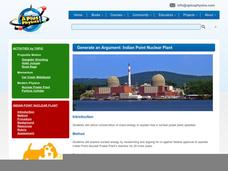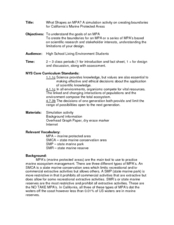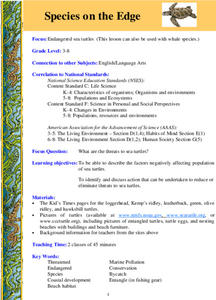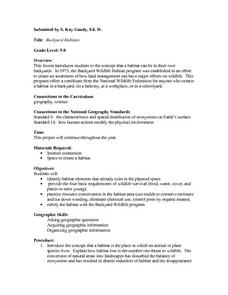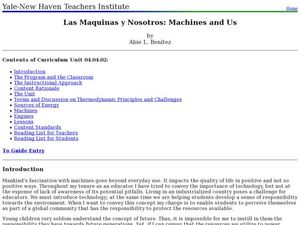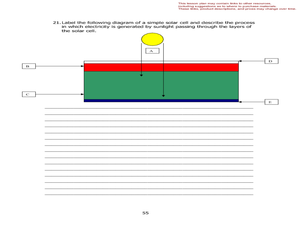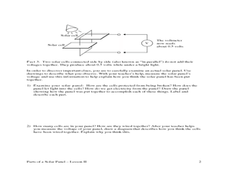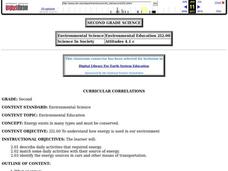Carnegie Mellon University
How Power Plants Work 2
In this second of three lessons on power plants, future engineers find out how we generate electricity and how coal-powered plants operate. They work in small groups to make electromagnet generators to light LED bulbs. A set of...
APlusPhysics
Generate an Argument: Indian Point Nuclear Plant
Small groups in your physics class collaborate on researching and forming an opinion on whether or not to continue operating the Indian Point nuclear power plant in New York. Once the information is gathered and an argument developed,...
Curated OER
Energetic Energy: A Child?s Guide to Responsible Energy Use
Students explore how energy transforms into heat. In this energy lesson students create models and find a need for fuel to make a Stirling engine.
Curated OER
What Shapes a MPA?
Young scholars identify the three types of MPA in California. For this marine science lesson, students analyze information provided to design a new MPA. They justify their reasoning in class.
Curated OER
Summer Camp 2050
Students create a camp for the future. In this simulation activity, students will research various energy sources, and create a proposal for the "city council" to recommend what energy sources should be used for a summer camp in the year...
Curated OER
Species on the Edge
Students describe factors negatively affecting population of sea turtles, and identify and discuss action that can be undertaken to reduce or eliminate threats to sea turtles and other endangered species.
Curated OER
Backyard Habitats
Students identify habitat elements. They create a habitat in a backyard, on a balcony, at a workplace, or in a schoolyard and provide the four basic requirements of wildlife survival (food, water, cover, and places to raise young). They...
Curated OER
Las Maquinas y Nosotros: Machines and Us
Second graders explain the relationship between energy and work. In this technology lesson, 2nd graders describe the different uses of machines in their everyday lives. They record observations and data in their science journal.
Curated OER
Environmental Law
Students analyze the environmental impact of pollution. They demonstrate an understanding of law, punishment and enforcement. Applying their knowledge, they create their own anti-pollution laws.
Curated OER
Photovoltaics and Solar Energy
Students experiment with photovoltaic cells and determine the energy use of their appliances. In this renewable energy lesson, students calculate the energy emitted by a photovoltaic cell through an inquiry-based lab. They keep track of...
Curated OER
Environmental Health Hazards and Children
Students are introduced to the environmental hazards their community is facing. In groups, they develop a list of the ways humans have changed the Earth and how these changes have lead to environmental hazards. They record their...
Curated OER
Recycling!
The students recall events from Dr. Seuss' story The Lorax and make connections to environmental issues affecting their lives. They are expected to reflect on the facts of the story and respond verbally stating the inferences they made...
Curated OER
What Is Happening To My Species?
Learners select and research an animal that lives in the rainforest of Manu, Peru. They watch and discuss a video, create masks and costumes to role-play various rainforest animals, conduct research, and write a short story of their...
Curated OER
Energy Efficient Buildings
Seventh graders create plans for an energy efficient addition to the school. They work in small groups with each group having responsibility for examining one aspect of the problem. They create working diagrams and a model of their...
Curated OER
Alternative Energy and Energy Saving Game
For this alternative energy and energy saving game worksheet, students create a multimedia game to present facts and influence people's behaviors about alternative energy sources, with links to helpful web resources.
Curated OER
Parts of a Solar Panel-Part II
Students discover how a mini-solar panel is constructed by behaving like detectives. Students examine an actual solar panel, measure the solar panel's voltage and use drawings to describe what they observe before completing questions...
Curated OER
Studying Birds in the Field
This is a well-designed science activity which helps learners learn the behavior of different species of birds. Working with partners and in small team, students learn to scientifically observe birds.
Curated OER
What Would Halloween be Like Without the Ecuadorian Rainforest?
Fourth graders are given a number of typical Halloween treats and work in groups to determine which foods came from the Rainforest (chocolate) and which foods came from temperate regions (apples, popcorn) and treats that don't have...
Curated OER
Environmental Education
Second graders discuss the different forms of energy and their sources. They work with a partner to answer a variety of questions revolving around energy. They develop a scientific attitude about renewable energy.
Curated OER
Where Have All the Dinosaurs Gone?
First graders listen to and discuss Patrick's Dinosaurs by Carol Carrick. They have a pretend dinosaur dig using dog biscuits and chicken bones. Students discuss how fossils are formed and make reproductions of them. After discussing the...
Curated OER
Beaver, or not?
Learners study the role of the beaver in Illinois during the 1800's and how overtrapping cause the near extinction of the beaver colonies in Illinois by 1900. Students role play various people in 1945 who have an opinion about the...
Curated OER
WaterWeb
In this water instructional activity, students answer 10 multiple-choice questions about the water cycle. Students also describe how they think their community is involved in sustaining water resources and write a pretend radio...
Curated OER
The Greenhouse Effect
Eighth graders research the Greenhouse Effect on the Internet. They use a variety of sources and take notes on the topic. They use ClarisWorks to type a report, use spellcheck, proof and edit. They can create a class bulletin board.
Curated OER
The Dirt on Worms!
Fourth graders make predictions, observe, collect and record data. They investigate several soil and worm websites. Finally, 4th graders write a letter to The President which defends earthworms by explaining their value to the United...

